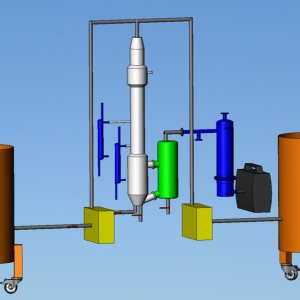Concentration by evaporation is a process for eliminating water by boiling with the vapor (called primary) as coolant, which gives up its latent heat to the product to be evaporated. The surface of the heater in contact with the product therefore compartmentalizes the device into an evaporator and a vapor condenser.
Studies of the following experimental parameters:
- Continuous concentration of a solution by evaporation.
- Influence of operating conditions.
Calculations:
- Thermal balances
- Material balances
Any evaporator must be considered as a latent heat exchanger whose limiting transfer is the internal heat transfer through the layer of product to be concentrated.
Vacuum evaporation is used for two main reasons. Firstly, for a given heating vapor pressure, the temperature difference between the vapor and the product is greater, which makes it possible either to increase the evaporative capacity, or to provide the evaporator with a greater number of effect and thus reduce steam consumption. Second, the use of vacuum allows solutions to evaporate at lower temperatures, thus limiting thermal denaturations for example.
Any evaporation must satisfy three industrial imperatives which are a high evaporative capacity, a low specific energy consumption and an ability to preserve the quality of the concentrated product.
Pilot whose entire process circuit is in 304L stainless steel except the recipes which are in borosilicate glass.
Power supply by peristaltic pump: flow 10 to 40 L / h
Evaporative capacity: 11 kg / h
Maximum dynamic viscosity: 2500 mPa.s
- Tank produced in 304L stainless steel of 100L, with cover, drain and on casters.
- Stainless steel 304L feed tank of 100L, with cover, drain and on wheels.
- A feed pump (variable speed).
- The feed pump is also used for washing.
- A draw-off pump (variable speed) (option).
- The draw-off pump is also used for washing (option).
- First descending film evaporators: double-walled 304L stainless steel exchanger, the steam circulates in the outer casing, the product in the 3 central 304L stainless steel tubes (heat exchange surface 0.12 m²). The exchanger is fitted with an external thermal insulation and baffles in the external casing to increase the heat capacity of the system.
- The steam pressure in the first system is regulated by a proportional stainless steel solenoid valve, The solenoid valve can be piloted "manually".
- Cylindrical-conical 304L stainless steel decanter / cyclone for liquid - vapor separation.
- 1 window with lighting to visualize the change in the viscosity of the milk as a function of time.
- 1 Vertical condenser: 304L stainless steel coil exchanger.
- 2 Quad-tube refrigerants in 304L stainless steel.
- 3 Borosilicate glass recipes, graduated; useful volume 5 liters.
- Heating steam expansion and regulation circuit with operator protection panel.
- Butterfly type process valve for selection valves, clamp connection.
- Process piping in 304L stainless steel with removable clamp and SMS type fittings.
- Reinforced PVC piping for the coolant.
- Borosilicate glass vacuum trap with vacuum rod (option).
- A vacuum pump with vacuum pressure regulation by leakage via a stainless steel needle valve (option).
- A command and control cabinet, IP55, equipped:
- an emergency stop,
- start buttons,
- a 10 '' touch screen for control, display and data acquisition.
- 304L stainless steel support frame with castors, 2 of which are locking.
Instrumentations:
- Temperature sensors: type PT100 class A precision 0.3 ° C.
- Piezo-resistive pressure sensor, accuracy 0.5% on the steam line.
- "Bourdon & nbsp;" type pressure gauge, -1 to +0.6 bar on the vacuum line (optional service N ° 2).
- High level probes.
- Electronic float flowmeter for the product on the supply line.
- Electromagnetic flowmeter on the milk recirculation line.
- Cooling water supply for the condenser equipped with a float flowmeter with its adjustment valve and a water circulation controller to stop the heating due to lack of cooling.
OPTION N ° 1: Draw-off pump.
If this is not taken with the basic offer, the system will be recirculated via peristaltic pump N ° 1 using a valve set.
OPTION N ° 2: vacuum pump.

 Print / download the product sheet
Print / download the product sheet